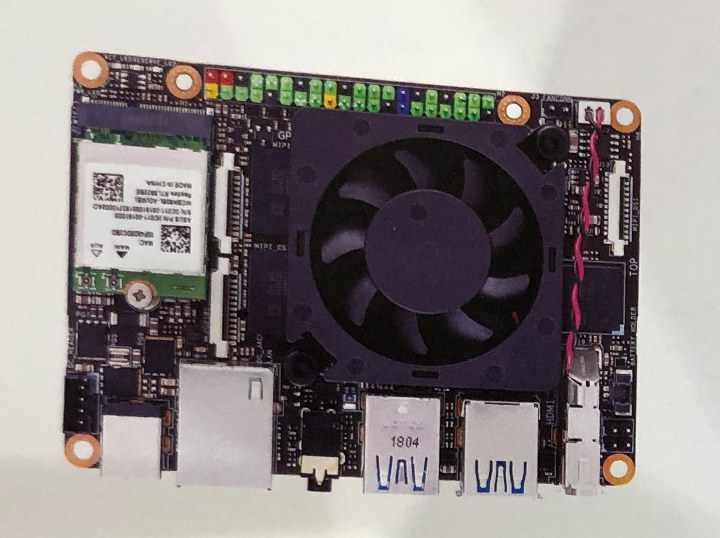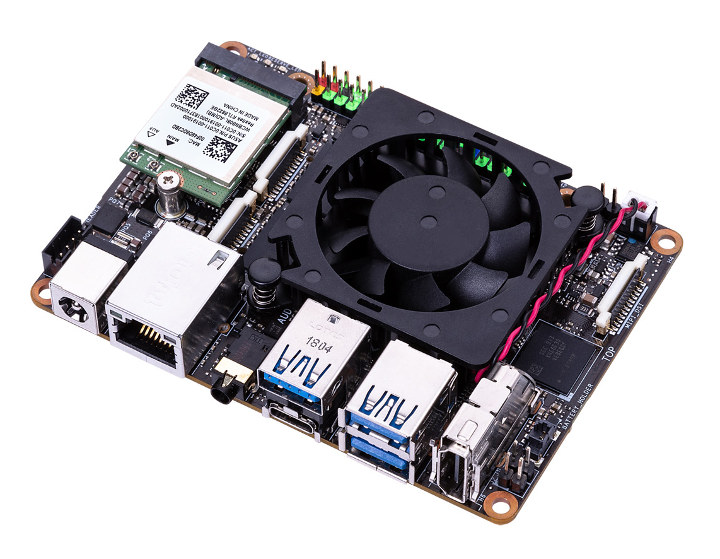Just a few days ago, we wrote about ASUS Tinker Edge T board and other products from ASUS featuring Google Coral Edge TPU which were showcased at Computex 2019. It turns out the company is working on another Tinker with a processor featuring an neural network accelerator. Meet ASUS Tinker Edge R Pico-ITX SBC powered by Rockchip RK3399Pro hexa-core processor equipped with a 3.0 TOPS NPU.

One of the reasons it did not get noticed is that ASUS may not have had a sample for display at the event, but instead only described the board in a brochure. [Update: ASUS Tinker Edge R was also showcased at Computex 2019]
ASUS Tinker Edge R SBC preliminary specifications:
- SoC – Rochchip RK3399Pro hexa-core big.LITTLE processor with 2x Cortex A72 cores up to 1.8 GHz, 4x Cortex A53 cores @ 1.4 GHz, an Arm Mali-T860 MP4 GPU up to 800 MHz with OpenGL ES 1.1 to 3.2, OpenVG1.1, OpenCL 1.2 and DX 11 support, and NPU delivering up to 3.0 TOPS
- System Memory – 4 GB dual-channel LPDDR4 memory for system, 2 GB LPDDR3 memory for NPU
- Storage – 16GB eMMC flash, micro SD card slot
- Video Output – HDMI, DisplayPort via USB-C port, up to 2x MIPI DSI connector (one MIPI connector is multiplexed with DSI or CSI available)
- Audio – 3.5mm audio jack
- Camera – Up to 2x MIPI CSI-2 connectors
- Connectivity – Gigabit Ethernet, 802.11ac WiFi 5, Bluetooth 4.2 2T2R
- USB – 3x USB 3.1 gen1 ports, 1x USB 3.1 gen 1 type-C OTG port
- Expansion
- mPCIe slot for 4G/LTE extended; nanoSIM card slot on-board
- 40-pin GPIO header with same pinout as original Tinker board with I2C, SPI, UART, PWM, I2S, and GPIOs
- Misc – RTC battery header, power-on header, header for reset button
- Power Supply – 12V to 19V input via power barrel jack or header
- Dimensions – 100 x 72mm (Pico-ITX form factor)

The board will come with fully open-source kernel and support for multiple APIs, including OpenGL, Vulkan, OpenCL, OpenVX, TensorFlow Lite, Android NN, and Caffe.
Hardware specifications are subject to changes before mass production gets underway. It’s unclear when the board will become available, and at what price, but based on pricing for Toybrick RK3399Pro board, it should be quite over $200 in this configuration.

Jean-Luc started CNX Software in 2010 as a part-time endeavor, before quitting his job as a software engineering manager, and starting to write daily news, and reviews full time later in 2011.
Support CNX Software! Donate via cryptocurrencies, become a Patron on Patreon, or purchase goods on Amazon or Aliexpress




